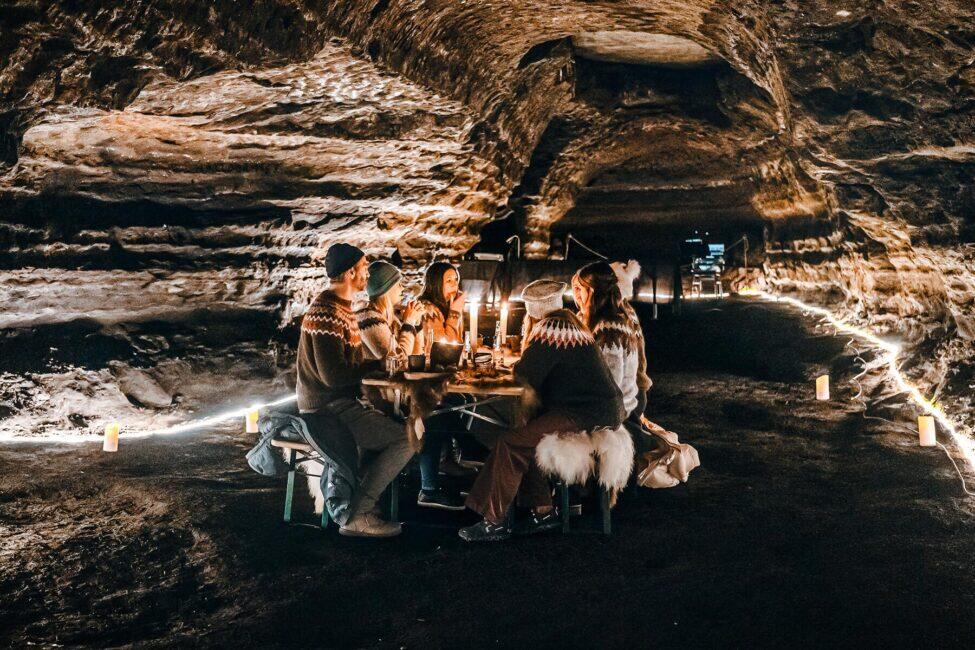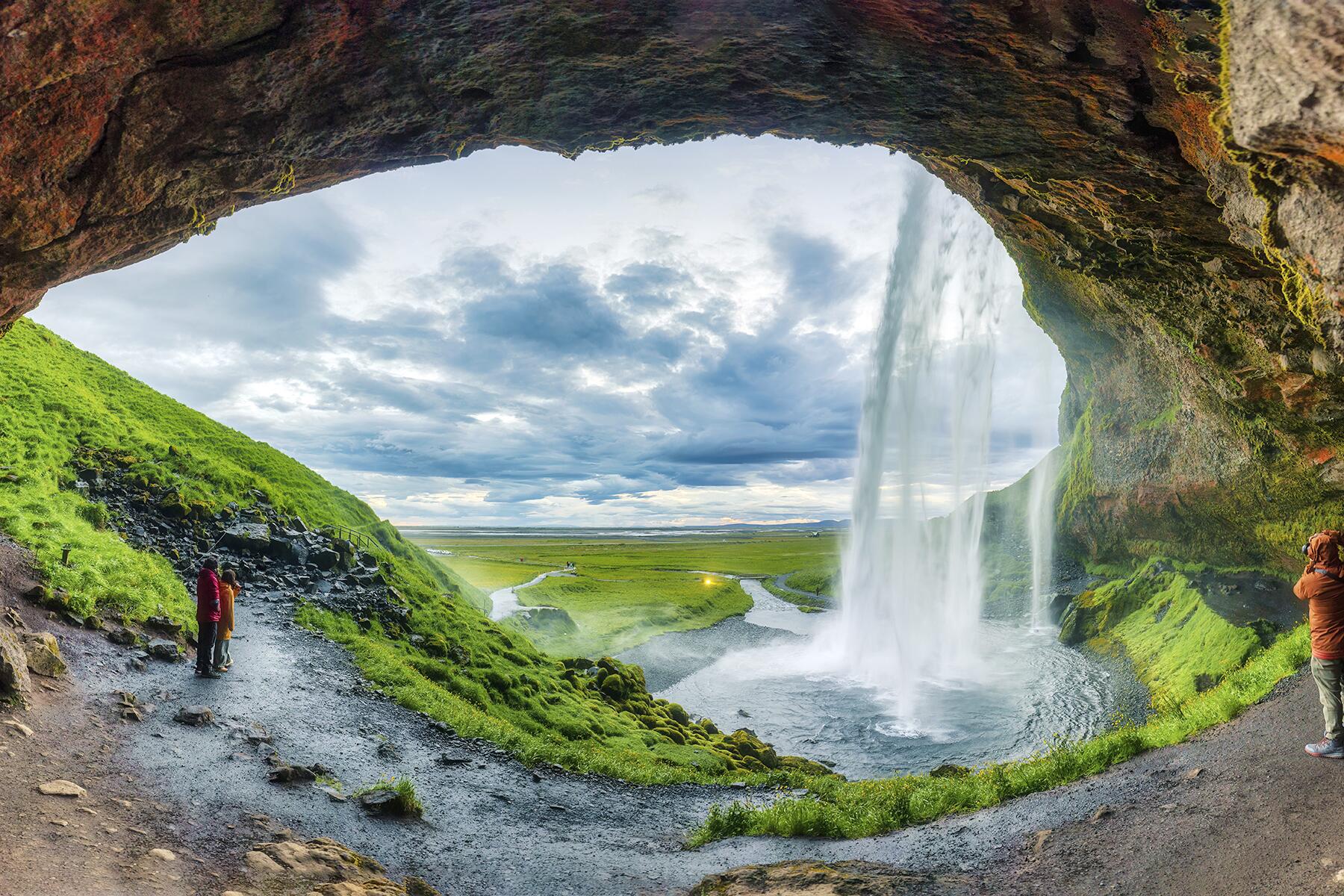Channel your inner Viking at this Viking-themed dinner inside a mysterious remote cave in Iceland.
In Iceland, rumors of Huldufólk—the country’s most common type of elf—have persisted for centuries. The human-esque people are said to live behind the country’s boulders, inside forests, and within a magical realm accessed from mountains and caves.
But in the small town of Hella, roughly 90 miles south of Reykjavik, it’s a different mysterious people who may have lived in the area millennia ago. But just as with Huldufólk, finding proof of those mysterious people could change everything historians know about the founding of Iceland.
Opened to the public in 2019, the Caves of Hella welcomes several tour groups a day of tourists who come to walk through four of the 12 known caves. The farms where the caves are have been privately owned by the same family for more than 200 years. While most of their history has been lost to time—or maybe never recorded in the first place—the family says it’s been known for nearly 1,000 years that there were some caves in the area.
With a bit of advanced planning, a few lucky visitors can arrange what is probably the most incredible dining experience in Iceland and likely one of the coolest in Europe: a private Viking-themed dinner held inside the mysterious caves, complete with wooden plates, sheepskin throws, and plenty of lopapeysas (patterned wool sweaters) to keep everyone warm in the roughly 32-degree subterranean chamber.
Recommended Fodor’s Video
The experience is booked through Iceland’s nearby Hotel Ranga, and when you arrive at the tiny wooden door that leads to the caves, which can be easily mistaken for a dilapidated shed, diners step into what could be the biggest mystery in Iceland.

Vikings Are an Intrinsic Part of Iceland’s History
“We wanted our guests to connect with the primitive ways of life for Icelanders during the Viking ages,” says Eyrún Aníta Gylfadóttir, Hotel Ranga’s marketing manager, who developed the dinner offering.
Vikings didn’t live in caves (though they may have used ones that already existed in Iceland for ceremonial or spiritual purposes). But given that so many of the hotel’s guests are interested in history, it seemed like a good fit.
The menu for the cave experience is based on a traditional Viking diet, says Gylfadóttir. And while dishes like raw puffin and fish porridge may not sound appetizing to modern-day travelers, with a little tweak, they suddenly become a lot more appetizing (though Hotel Ranga does serve puffin tartar).
“No one knows exactly what a Viking dinner was like, but we have good ideas,” says Gylfadóttir. Ranga chefs worked to create a modern-day menu based on dishes they knew would have been available around 1000 B.C.E., swapping steamed sheep heads for lamb shank and seasoned bulgur and dried char for smoked salmon crostini on fresh-baked bread.
Interestingly, your average Viking likely wouldn’t have batted an eye at the dessert offering: yogurt-like skyr topped with locally grown blueberries. It’s a desert whose production methods haven’t changed much since Iceland’s early days. Guests are hosted at a communal table with a wooden plate and a volcanic stone drinking cup at each seat. And in true Viking style, table scaping is an unnecessary formality, with just a single wooden utensil to attack each dish. The use of one’s hands is highly encouraged.
INSIDER TIPDinners are booked via Hotel Ranga and start at €2,000. A one-week’s notice is required to book. The chefs can accommodate most dietary restrictions, and the experience is capped at eight people.
Guests enter the dimly lit cave to the sound of live accordion music. And, in a twist not surprisingly for Hella’s population of roughly 900, the musician is none other than Gylfadóttir of Hotel Ranga. Accordions were invented in the 1880s, so it’s not the same music the Vikings would have listened to. But Gylfadóttir says the music was so popular with guests of the trial dinner that they decided to make it a standard part of the experience. And really, considering the unknowns looming around the Caves of Hella, what music Vikings listened to barely registers against the backdrop of more pressing questions.

Almost Everything About the Caves of Hella Is Unknown
The biggest mysteries around the Caves of Hella are, well, basically everything, says Dr. Elizabeth Lastra, assistant professor of art at Vassar College and co-lead on the first modern-day, sustained scholarly research project on the caves. Her team is trying to gather basic information on them, like who built them, why, and whether they’re related to the more than 200 other caves throughout southern Iceland. The one thing researchers do suspect about the Caves of Hella—when they were built—puts their creation sometime before what Icelanders call “Settlement Times,” a period from roughly the mid-9th century to the mid-10th century.
But according to conventional Icelandic history, there were only a few Irish monks, called “papas,” in the country before the Settlement Times. But as Caves of Hella tour guide Stefán Smári Ásmundarson pointed out, “a few Celtic monks didn’t build 200 caves.” Obviously, this raises a few big questions.
“Anything with the potential to overturn the origin story of a country is controversial,” says Lastra of her team’s research. Their on-the-ground research is wrapping up now, and analyzing the data and findings is underway. Lastra says they’re currently considering two genesis timelines. The first is that they were built by Icelanders—i.e., former Vikings who had since converted to Christianity—around 1000 B.C.E. That would support the current written history of Iceland, which says that the country was primarily uninhabited before Nordic people arrived around the 800s B.C.E. But the second theory could certainly upset some Icelandic historians: The caves were built by settlers from the northern British Isles in the Early Middle Ages, around the 6th and 7th centuries.

The Vassar team isn’t the first to posit that Celts existed in large numbers in Iceland before the Vikings. “Other nearby caves at Seljaland, which are less accessible to the public, have also been hypothesized by scholar Kristján Ahronson to pre-date Viking arrival,” says Laura Haynes, an Assistant Professor of Earth Science co-leading the project with Lastra. She says Iceland likely was empty before humans arrived: “Prior to their arrival, the largest native land animal was the Arctic fox.”
But there may be a missing period in Icelandic history, and Haynes says the lack of significant historical records doesn’t mean there’s no proof of that being possible. “Some stratigraphic evidence from ash layers may also point to an earlier date of arrival, which could support an earlier settlement history,” she says. By using techniques like sediment analysis, x-ray imaging to studying the chemicals within the rock walls, and Reflectance Transformation Imaging (RTI) to photograph textures and differences in cave markings, the Vassar team hopes to make more confident conclusions on some of the basic mysteries surrounding the caves.

Mysteries Aside, the Viking Dinner Is the Epitome of an Icelandic Experience
While conclusions could suggest that the Caves of Hella were built by Celts, indicating a much larger pre-Viking European presence than historians believed, Gylfadóttir says the dinner will continue to be Viking-themed. That’s not just because the Vikings are so closely associated with Iceland’s history but because the town of Hella played a key role in the country’s oldest Viking stories.
“As locals, we are extremely proud of our story and our Viking heritage,” says Gylfadóttir. “One of Iceland’s greatest Viking sagas, the Njáls’s saga, takes place in the countryside close to Hotel Rangá.”

That close link to Iceland’s history inspired Gylfadóttir and her staff to create an experience for guests that connected them to the history of the land around Hella. “Our history is based on the first Viking, Ingólfur Arnarson, who discovered Iceland around 850 A.D,” she says. His tale, along with others of Nordic settlers, are the first written records of any European settlement in the country. They’re recounted in the country’s Landnámabók or book of settlements. “Celtic is not really part of our history,” says Gylfadóttir, even if newly discovered archaeological evidence could soon suggest otherwise.
While the Vassar team is eager to learn more about the oldest archeological site in the land of ice and fire, they’re not looking to draw any particular conclusions. “We’re interested in learning as much as we can about these curious artificial caves, from who carved them and when,” says Haynes. “Which relates to the big question of what they might tell us about the settlement history of Iceland.”




